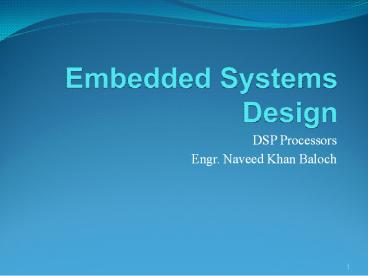Embedded Systems Design - PowerPoint PPT Presentation
Title:
Embedded Systems Design
Description:
... and Analog to digital ... Digital Signal Processor Electronic ... MAC units and fast multipliers are used for many DSP algorithms for ... – PowerPoint PPT presentation
Number of Views:112
Avg rating:3.0/5.0
Title: Embedded Systems Design
1
Embedded Systems Design
- DSP Processors
- Engr. Naveed Khan Baloch
2
Digital Signal Processing
- Processing of digitally represented signals
- Signals represented digitally via sequence of
samples - Digital signals obtained from physical signals
via Transducers and Analog to digital convertors
(ADC) - Digital Signal Processor
- Electronic system that processes digital signals
3
Definition
- A digital signal processor (DSP) is a specialized
microprocessor with optimized architecture for
fast operational needs of Digital Signal
Processing.
4
DSP Applications
- Audio
- Coding, Decoding, Surround-sound
- Communication
- Scrambling, Cellular phones, software radios
- Control
- Robotics, Disk drive control, motor control
- Medical
- Diagnostics equipment, hearing aids
- Defense
- Radar and sonar processing, missile guidance
5
Why DSP Processors ?
- Reprogrammable
- Cost effective
- Fast computation
- Energy Efficiency
- Fast Multipliers
- Multiple Execution Units
- Efficient Memory Accesses
- Circular Buffering
- Data Format
- Zero-Overhead Looping
- Streamlined I/O
- Specialized Instruction Sets
- SIMD
6
Reprogrammable
7
Cost Effective
- There is no need for a separate signal processing
unit - Signal processing and control functions can be
performed on a single silicon chip
8
Faster computation
- Because of specialized Hardware for DSP
application computation becomes vary fast - Separate MAC units and fast multipliers are used
for many DSP algorithms for faster execution i.e. - FIR Filter
- IIR Filter
- DCT
- FFT
9
Fast Multipliers
- Originally, microprocessors implemented
multiplications by a series of shift and add
operations, each of which consumed one or more
clock cycles. - Most DSP processors can only take one clock cycle
for the multiplication operation. - modern DSP processors include at least one
dedicated single- cycle multiplier or combined
multiply-accumulate - (MAC) unit
10
Multiple Execution Units
- DSP applications typically have very high
computational - requirements in comparison to other types of
computing - tasks, since they often must execute DSP
algorithms (such - as FIR filtering) in real time on lengthy
segments of signals sampled at 10-100 KHz or
higher. Hence, DSP processors often include
several independent execution units that are
capable of operating in parallelfor example, in
addition to the MAC unit, they typically contain
an arithmetic- logic unit (ALU) and a shifter.
11
Efficient Memory Accesses
- Small bank of RAM near the processor core that
- is used as an instruction cache
- Many DSP processors also support circular
addressing, which allows the processor to access
a block of data sequentially and then
automatically wrap around to the beginning address
12
Circular Buffering
- The process by which the Data Address Generator
(DAG) wraps around or repeatedly steps through
a range of registers. - Instructions Accommodate 3 elements
- Buffer Address
- Buffer Size
- Increment
13
Data Format
- Fixed point and floating point processors.
- Use of Accumulator to reduce the overflow.
14
Zero-Overhead Looping
- Special loop or repeat instruction is provided
which allows the programmer to implement a
for-next loop without expending any clock cycles
for updating and testing the loop counter or
branching back to the top of the loop. This
feature is often referred to as zero-overhead
looping.
15
Streamlined I/O
- To allow low-cost, high-performance input and
output, most DSP processors incorporate one or
more specialized serial or parallel I/O
interfaces, and streamlined I/O handling
mechanisms, such as low-overhead interrupts and
direct memory access (DMA), to allow data
transfers to proceed with little or no
intervention from the processor's computational
units.
16
Specialized Instruction Sets
- DSP processor instruction sets have traditionally
been - designed with two goals in mind
- Maximum use of the processor's underlying
hardware - Minimize the amount of memory space required to
store DSP programs - Highly Specialized
- Complicated
- Irregular
- Use Assembly instead of C for maximum benefit
17
SIMD
- SIMD, or single-instruction, multiple-data, is
not a class of architecture itself, but is
instead an architectural technique that can be
used within any of the classes of architectures - Improves performance on some algorithms by
allowing the processor to execute multiple
instances of the same operation - For example, a SIMD multiplication instruction
could perform two or more multiplications on
different sets of input operands in parallel in a
single clock cycle.































